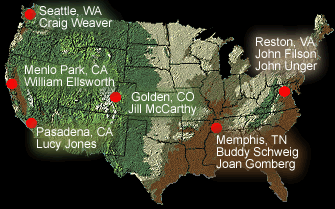 This
web site is provided by the United States Geological Survey’s
Earthquake Hazard Program as part of our effort to
reduce earthquake hazard in the United States. We are part
of the USGS Geologic Division, and receive funding
from the USGS Earthquake Hazards Program, which is funded,
in turn, by the National Earthquake Hazards Reduction
Program (NEHRP). The Geomagnetism
Program is also funded under the Earthquake Hazards
Program. This
web site is provided by the United States Geological Survey’s
Earthquake Hazard Program as part of our effort to
reduce earthquake hazard in the United States. We are part
of the USGS Geologic Division, and receive funding
from the USGS Earthquake Hazards Program, which is funded,
in turn, by the National Earthquake Hazards Reduction
Program (NEHRP). The Geomagnetism
Program is also funded under the Earthquake Hazards
Program.
Earthquakes
pose significant risk to 75 million Americans in 39 States.
The
USGS is the only Federal agency with responsibility for
recording and
reporting earthquake activity nationwide. Citizens, emergency
responders,
and engineers rely on the USGS for accurate and timely
information on where
an earthquake occurred, how much the ground shook in different
locations,
and what the likelihood is of future significant ground
shaking.
 The USGS estimates
that several million earthquakes occur in the world each
year, but many go undetected because they occur in remote
areas or have
very small magnitudes. The USGS now locates about 50
earthquakes
each day;
20,000 a year.
The USGS estimates
that several million earthquakes occur in the world each
year, but many go undetected because they occur in remote
areas or have
very small magnitudes. The USGS now locates about 50
earthquakes
each day;
20,000 a year.
The USGS is
working to improve its earthquake monitoring and reporting
capabilities through the Advanced National Seismic System.
In the past
three years the USGS has installed approximately 300 new
earthquake
monitoring instruments in the San Francisco, Seattle, Salt
Lake City,
Anchorage, Reno, Las Vegas, and Memphis areas. Full implementation
of ANSS
will result in 6000 new instruments on the ground and in
structures. Once
in place, the ANSS will provide emergency response personnel
with real-time
(within 5-10 minutes of an event) information on the intensity
and
distribution of ground shaking that can be used to guide
emergency response
efforts. Similarly, information on building "shaking" will
equip engineers
with the data they need to improve building designs in
the future.
|

